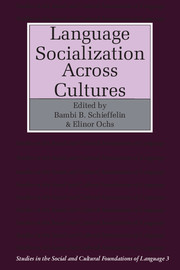Book contents
- Frontmatter
- Contents
- List of contributors
- 1 Introduction
- Part I Acquiring language and culture through interactional routines
- Part II Acquiring knowledge of status and role through language use
- Part III Expressing affect: input and acquisition
- 8 Teasing and shaming in Kaluli children's interactions
- 9 Teasing: verbal play in two Mexicano homes
- 10 Teasing as language socialization and verbal play in a white working-class community
- 11 The acquisition of communicative style in Japanese
- 12 From feelings to grammar: a Samoan case study
- Index
8 - Teasing and shaming in Kaluli children's interactions
Published online by Cambridge University Press: 05 June 2012
- Frontmatter
- Contents
- List of contributors
- 1 Introduction
- Part I Acquiring language and culture through interactional routines
- Part II Acquiring knowledge of status and role through language use
- Part III Expressing affect: input and acquisition
- 8 Teasing and shaming in Kaluli children's interactions
- 9 Teasing: verbal play in two Mexicano homes
- 10 Teasing as language socialization and verbal play in a white working-class community
- 11 The acquisition of communicative style in Japanese
- 12 From feelings to grammar: a Samoan case study
- Index
Summary
Introduction
An important issue facing researchers interested in language socialization is how children learn to use culturally appropriate rhetorical means to negotiate and accomplish certain pragmatic ends. For example, how do young children acquire the culturally specific routines and affective displays necessary to manipulate others to obtain what they want and keep what they do not wish to give up?
This chapter examines exchanges in which Kaluli adults verbally tease and shame children to achieve a variety of ends. Teasing and shaming, two related speech acts and speech events, figure prominently in Kaluli adult-adult and adult-child verbal interaction. Kaluli adults try to avoid physical intervention when trying to influence others, especially small children. Instead, they prefer verbal manipulation through teasing and shaming, and socialize their children to do the same. As in many other Pacific cultures, such as Samoa (Ochs in press), one of the major ways in which social control is achieved is through members' fear of being publicly confronted and shamed. This is especially the case when individuals take something that is not theirs to take, as in cases of theft or adultery. When members feel that the risk of getting caught is low, they may attempt such acts, and, if they are not caught, there may be little consequence for them. However, if they are caught, confrontation can occur, and shaming, which is serious, will be public.
- Type
- Chapter
- Information
- Language Socialization across Cultures , pp. 165 - 181Publisher: Cambridge University PressPrint publication year: 1987
- 7
- Cited by

